A 3D Anisotropic Thermomechanical Model for Thermally Induced Woven-Fabric-Reinforced Shape Memory Polymer Composites
Abstract
:1. Introduction
2. Constitutive Model
2.1. Kinematics
2.2. Constitutive Model for Matrix SMPs
2.3. Constitutive Model for Fabric
3. Parameters for Determining Protocol and Model Verification
3.1. Methods for Determining Matrix SMPs Material Parameters
3.2. Methods for Determining Remaining Material Parameters
- Based on the Equations (18) and (22)–(24), can be determined by fitting the stress–strain curve of the 0° SMPCs at with an initial assumption of .
- With determined, can be obtained by fitting the stress–strain curve of the bias tension of the SMPCs based on Equations (18) and (22)–(24).
- can be obtained by fitting the curve of the strain of the 0° SMPCs in the loading step, cooling step, and unloading step in the shape memory cycle.
- Compare the fitting results with the experimental data. If good consistency has been achieved, then these parameters are determined. If not, modify the initial estimate of the constant and return to (1).
- With the above parameter determined, can be obtained by fitting the curve of the strain of the 45° SMPCs in the loading step, cooling step, and unloading step in the shape memory cycle.
3.3. Model Verification
4. Conclusions
Author Contributions
Funding
Institutional Review Board Statement
Informed Consent Statement
Data Availability Statement
Acknowledgments
Conflicts of Interest
References
- Shin, J.; Han, Y.; Lee, J.; Han, M. Shape Memory Alloys in Textile Platform: Smart Textile-Composite Actuator and Its Application to Soft Grippers. Sensors 2023, 23, 1518. [Google Scholar] [CrossRef]
- Wang, W.; Kim, N.; Rodrigue, H.; Ahn, S. Modular assembly of soft deployable structures and robots. Mater. Horiz. 2017, 4, 367–376. [Google Scholar] [CrossRef]
- Wang, W.; Li, C.; Rodrigue, H.; Yuan, F.; Han, M.; Cho, M.; Ahn, S. Kirigami/origami-based soft deployable reflector for optical beam steering. Adv. Funct. Mater. 2017, 27, 1604214. [Google Scholar] [CrossRef]
- Shintake, J.; Cacucciolo, V.; Floreano, D.; Shea, H. Soft robotic grippers. Adv. Mater. 2018, 30, 1707035. [Google Scholar] [CrossRef] [PubMed] [Green Version]
- Schönfeld, D.; Chalissery, D.; Wenz, F.; Specht, M.; Eberl, C. Actuating shape memory polymer for thermoresponsive soft robotic gripper and programmable materials. Molecules 2021, 26, 522. [Google Scholar] [CrossRef] [PubMed]
- Ang, B.; Yeow, C.; Lim, J. A critical review on factors affecting the user adoption of wearable and soft robotics. Sensors 2023, 23, 3263. [Google Scholar] [CrossRef] [PubMed]
- Terrile, S.; Argüelles, M.; Barrientos, A. Comparison of different technologies for soft robotics grippers. Sensors 2021, 21, 3253. [Google Scholar] [CrossRef]
- Liu, Y.; Gall, K.; Dunn, M.; Greenberg, A.; Diani, J. Thermomechanics of shape memory polymers: Uniaxial experiments and constitutive modeling. Int. J. Plast. 2006, 22, 279–313. [Google Scholar] [CrossRef]
- Qi, H.; Nguyen, T.; Castro, F.; Yakacki, C.; Shandas, R. Finite deformation thermo-mechanical behavior of thermally induced shape memory polymers. J. Mech. Phys. Solids 2008, 56, 1730–1751. [Google Scholar] [CrossRef]
- Boatti, E.; Scalet, G.; Auricchio, F. A three-dimensional finite-strain phenomenological model for shape-memory polymers: Formulation, numerical simulations, and comparison with experimental data. Int. J. Plast. 2016, 83, 153–177. [Google Scholar] [CrossRef]
- Yang, Q.; Li, G. Temperature and rate dependent thermomechanical modeling of shape memory polymers with physics based phase evolution law. Int. J. Plast. 2016, 80, 168–186. [Google Scholar] [CrossRef] [Green Version]
- Yan, C.; Yang, Q.; Li, G. A phenomenological constitutive model for semicrystalline two-way shape memory polymers. Int. J. Mech. Sci. 2020, 177, 105552. [Google Scholar] [CrossRef]
- Yan, C.; Li, G. Tutorial: Thermomechanical constitutive modeling of shape memory polymers. J. Appl. Phys. 2022, 131, 111101. [Google Scholar] [CrossRef]
- Xue, Y.; Lei, J.; Liu, Z. A thermodynamic constitutive model for shape memory polymers based on phase transition. Polymer 2022, 243, 124623. [Google Scholar] [CrossRef]
- Tobushi, H.; Hashimoto, T.; Hayashi, S.; Yamada, E. Constitutive Modeling in Shape Memory Polymer of Polyurethane Series. J. Intell. Mater. Syst. Struct. 1997, 8, 711–718. [Google Scholar] [CrossRef]
- Tobushi, H.; Okumura, K.; Hayashi, S.; Ito, N. Thermomechanical constitutive model of shape memory polymer. Mech. Mater. 2001, 33, 545–554. [Google Scholar] [CrossRef]
- Diani, J.; Liu, Y.; Gall, K. Finite strain 3D thermoviscoelastic constitutive model for shape memory polymers. Polym. Eng. Sci. 2006, 46, 486–492. [Google Scholar] [CrossRef]
- Nguyen, T.; Qi, H.; Castro, F.; Long, K. A thermoviscoelastic model for amorphous shape memory polymers: Incorporating structural and stress relaxation. J. Mech. Phys. Solids 2008, 56, 2792–2814. [Google Scholar] [CrossRef]
- Nguyen, T.; Yakacki, C.; Brahmbhatt, P.; Chambers, M. Modeling the relaxation mechanisms of amorphous shape memory polymers. Adv. Mater. 2010, 22, 3411–3423. [Google Scholar] [CrossRef]
- Zeng, H.; Leng, J.; Gu, J.; Sun, H. A thermoviscoelastic model incorporated with uncoupled structural and stress relaxation mechanisms for amorphous shape memory polymers. Mech. Mater. 2018, 124, 18–25. [Google Scholar] [CrossRef]
- Prasad, A.; Moon, S.; Rao, I. Thermo-mechanical modeling of viscoelastic crystallizable shape memory polymers. Int. J. Eng. Sci. 2021, 167, 103524. [Google Scholar] [CrossRef]
- Bakhtiyari, A.; Baniasadi, M.; Baghani, M. A modified constitutive model for shape memory polymers based on nonlinear thermo-visco-hyperelasticity with application to multi-physics problems. Int. J. Appl. Mech. 2023, 15, 2350032. [Google Scholar] [CrossRef]
- Li, Y.; He, Y.; Liu, Z. A viscoelastic constitutive model for shape memory polymers based on multiplicative decompositions of the deformation gradient. Int. J. Plast. 2017, 91, 300–317. [Google Scholar] [CrossRef]
- Su, X.; Peng, X. A 3D finite strain viscoelastic constitutive model for thermally induced shape memory polymers based on energy decomposition. Int. J. Plast. 2018, 110, 166–182. [Google Scholar] [CrossRef]
- Su, X.; Wang, Y.; Peng, X. An anisotropic visco-hyperelastic model for thermally-actuated shape memory polymer-based woven fabric-reinforced composites. Int. J. Plast. 2020, 129, 102697. [Google Scholar] [CrossRef]
- Wang, Y.; Wang, J.; Peng, X. Refinement of a 3D finite strain viscoelastic constitutive model for thermally induced shape memory polymers. Polym. Test. 2021, 96, 107139. [Google Scholar] [CrossRef]
- Wang, Y.; Zhu, F.; Rao, Q.; Peng, X. A 3D finite strain viscoelastic model with uncoupled structural and stress relaxations for shape memory polymers. Polym. Test. 2021, 103, 107373. [Google Scholar] [CrossRef]
- Tan, Q.; Liu, L.; Liu, Y.; Leng, J. Thermal mechanical constitutive model of fiber reinforced shape memory polymer composite: Based on bridging model. Compos. Part A 2014, 64, 132–138. [Google Scholar] [CrossRef]
- Gu, J.; Leng, J.; Sun, H.; Zeng, H.; Cai, Z. Thermomechanical constitutive modeling of fiber reinforced shape memory polymer composites based on thermodynamics with internal state variables. Mech. Mater. 2019, 130, 9–19. [Google Scholar] [CrossRef]
- Li, F.; Leng, J.; Liu, Y.; Remillat, C.; Scarpa, F. Temperature dependence of elastic constants in unidirectional carbon fiber reinforced shape memory polymer composites. Mech. Mater. 2020, 148, 103518. [Google Scholar] [CrossRef]
- Wang, Y.; Zhou, H.; Liu, Z.; Peng, X.; Zhou, H. A 3D anisotropic visco-hyperelastic constitutive model for unidirectional continuous fiber reinforced shape memory composites. Polym. Test. 2022, 114, 107712. [Google Scholar] [CrossRef]
- Hong, S.; Jang, J.; Park, H.; Kim, J.; Yu, W. Three-dimensional constitutive model of woven fabric-reinforced shape memory polymer composites considering thermal residual stress. Smart Mater. Struct. 2019, 28, 035023. [Google Scholar] [CrossRef]
- Peng, X.; Guo, Z.; Du, T.; Yu, W. A simple anisotropic hyperelastic constitutive model for textile fabrics with application to forming simulation. Compos. Part B Eng. 2013, 52, 275–281. [Google Scholar] [CrossRef]
- Ge, Q.; Luo, X.; Iversen, C.; Nejad, H.; Mather, P.; Dunn, M.; Qi, H. A finite deformation thermomechanical constitutive model for triple shape polymeric composites based on dual thermal transitions. Int. J. Solids Struct. 2014, 51, 2777–2790. [Google Scholar] [CrossRef] [Green Version]
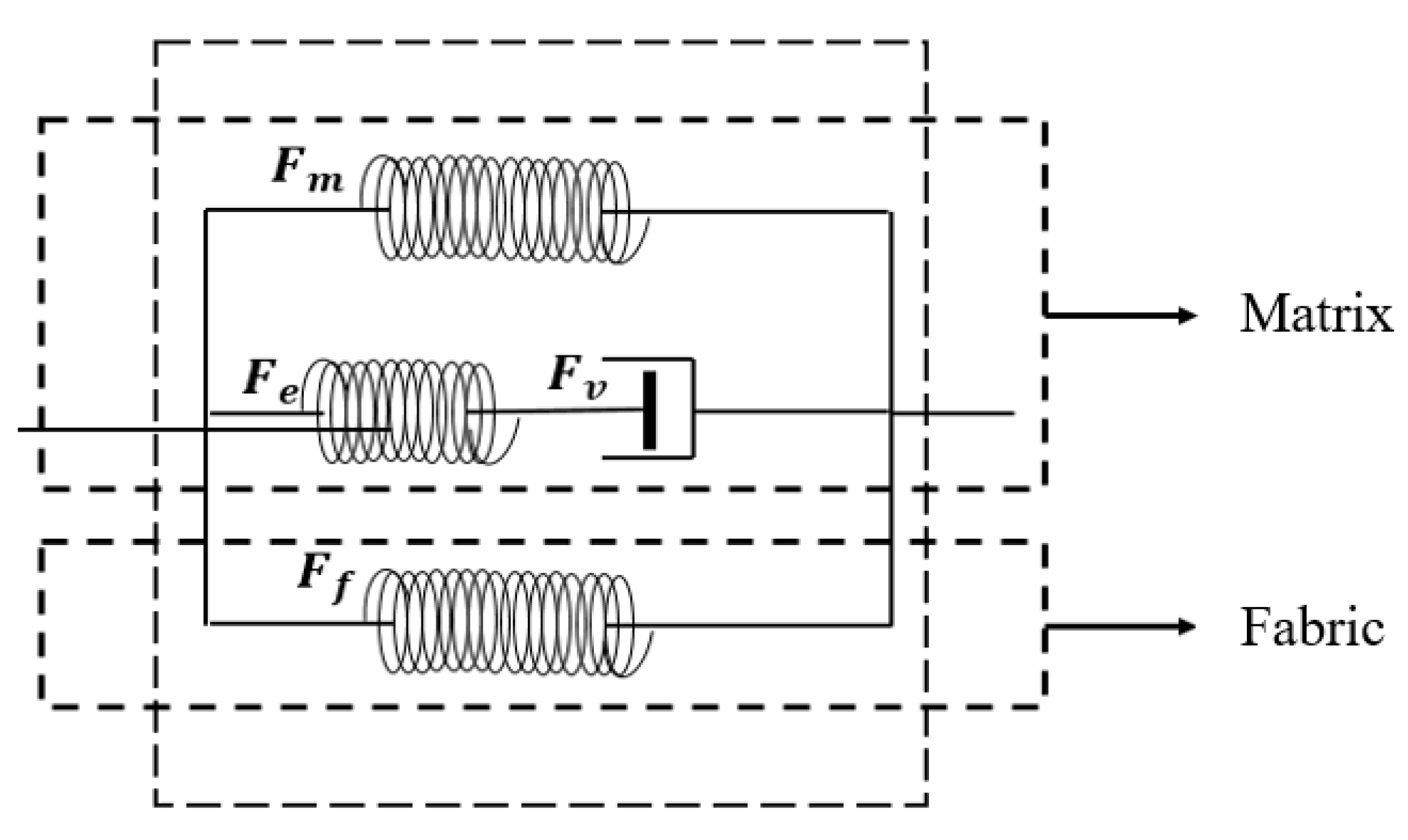
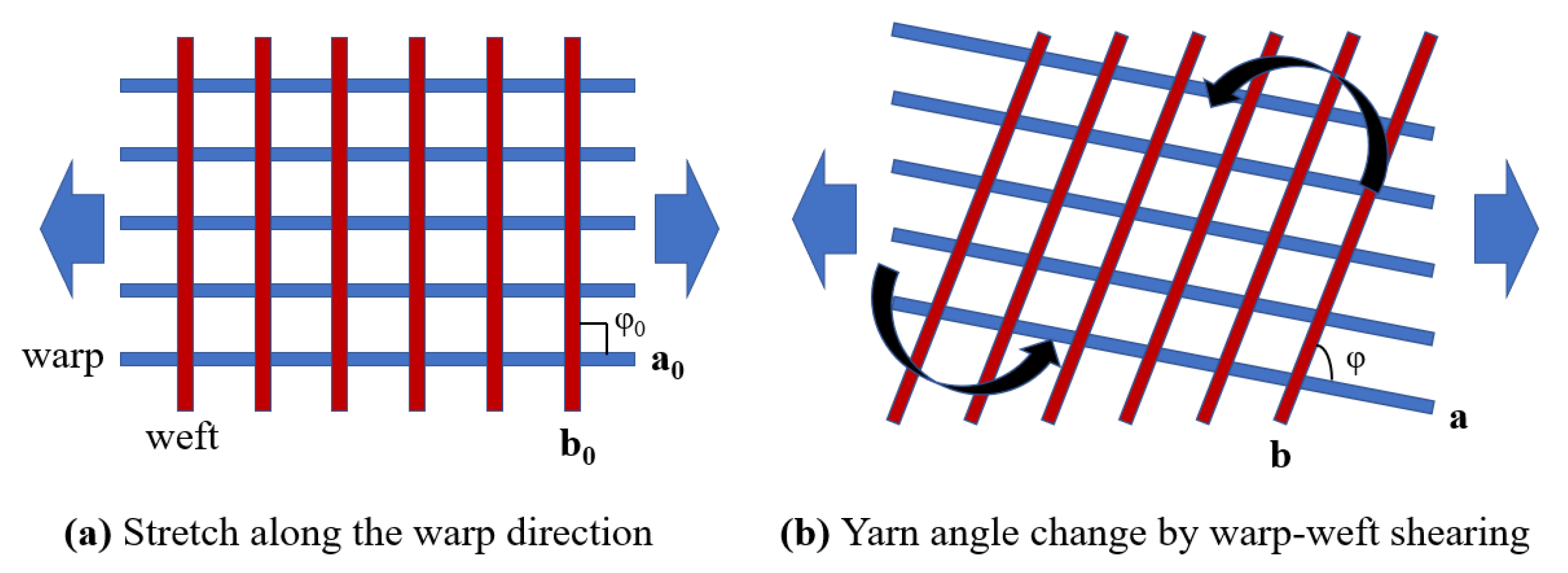
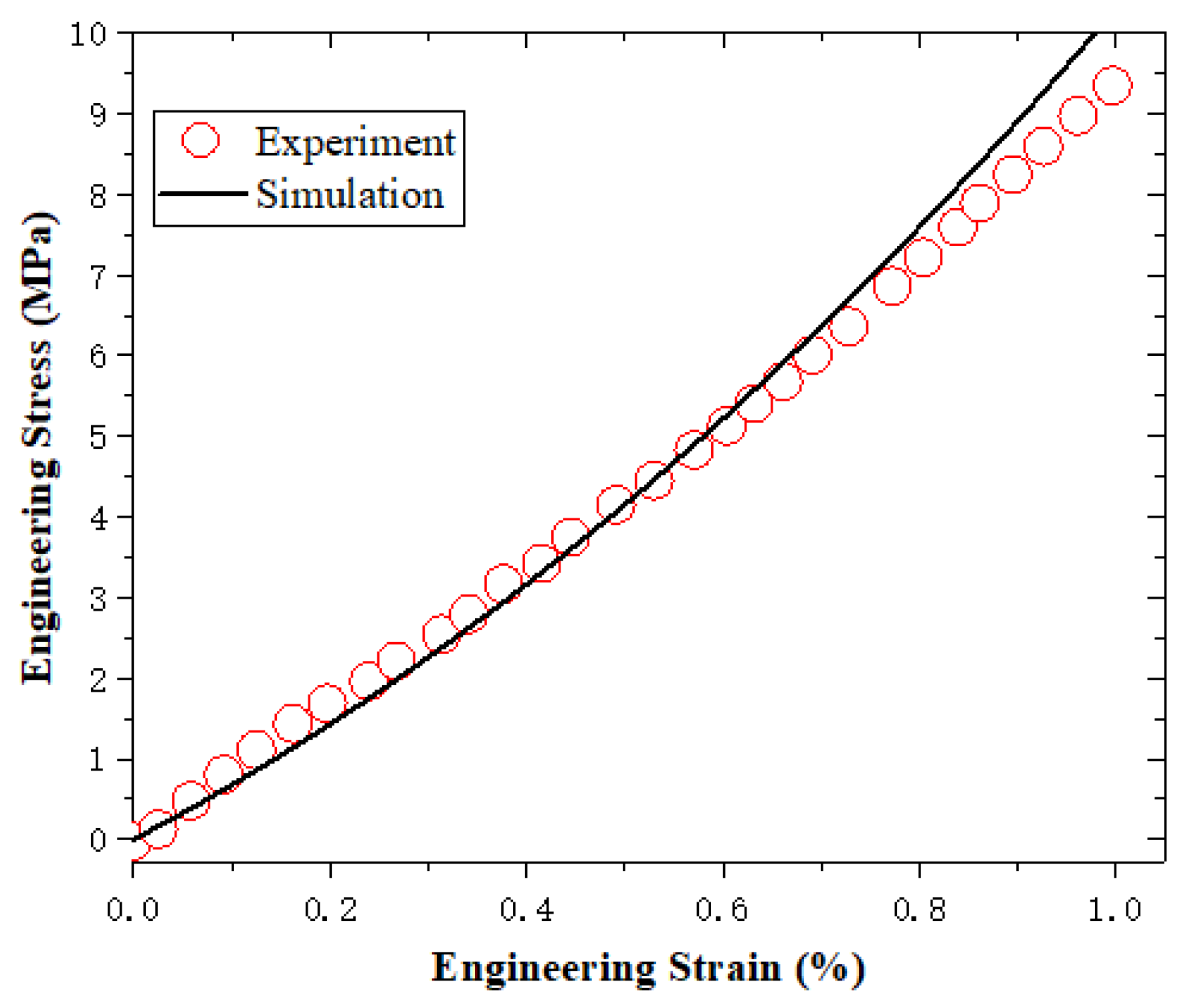

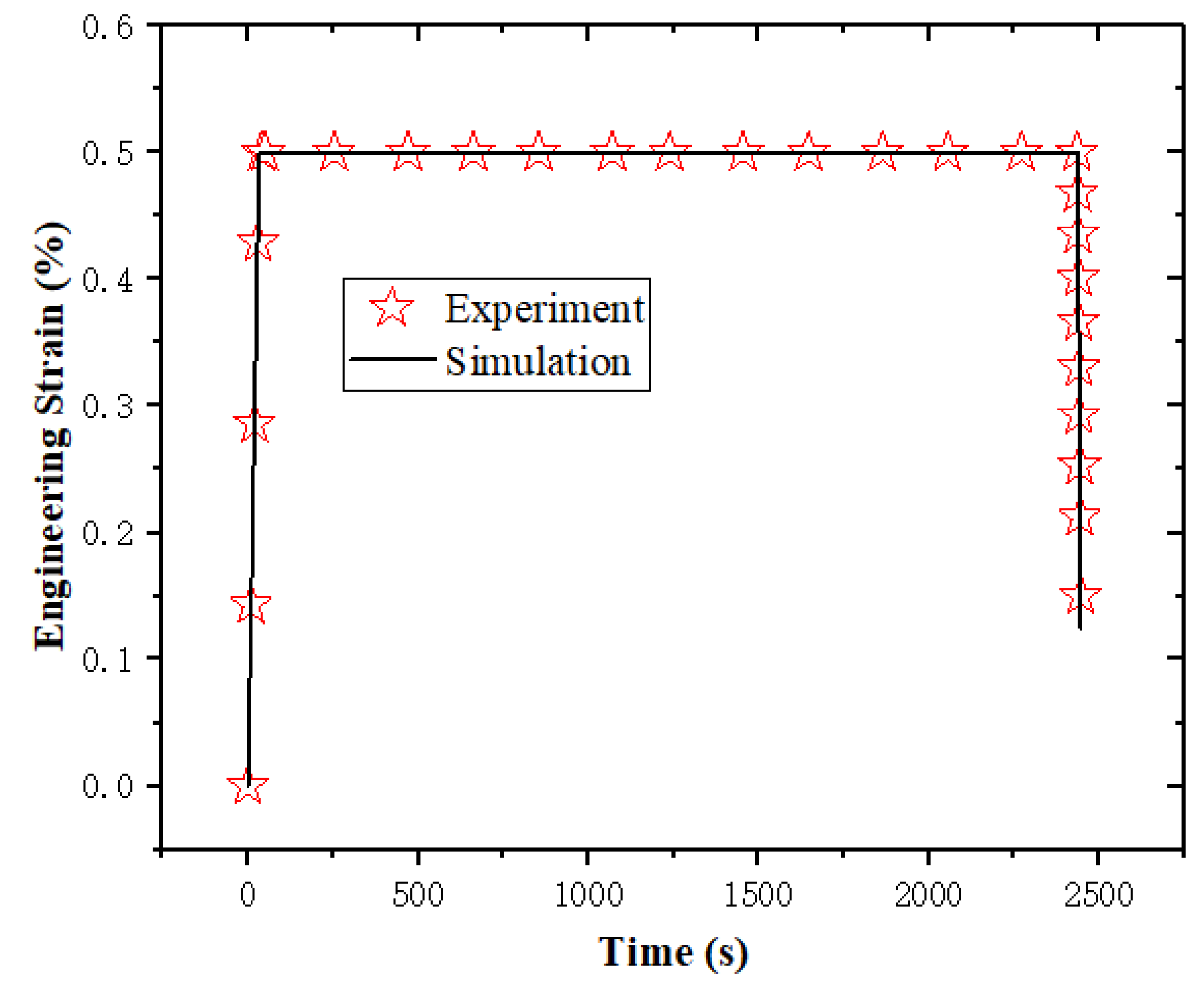
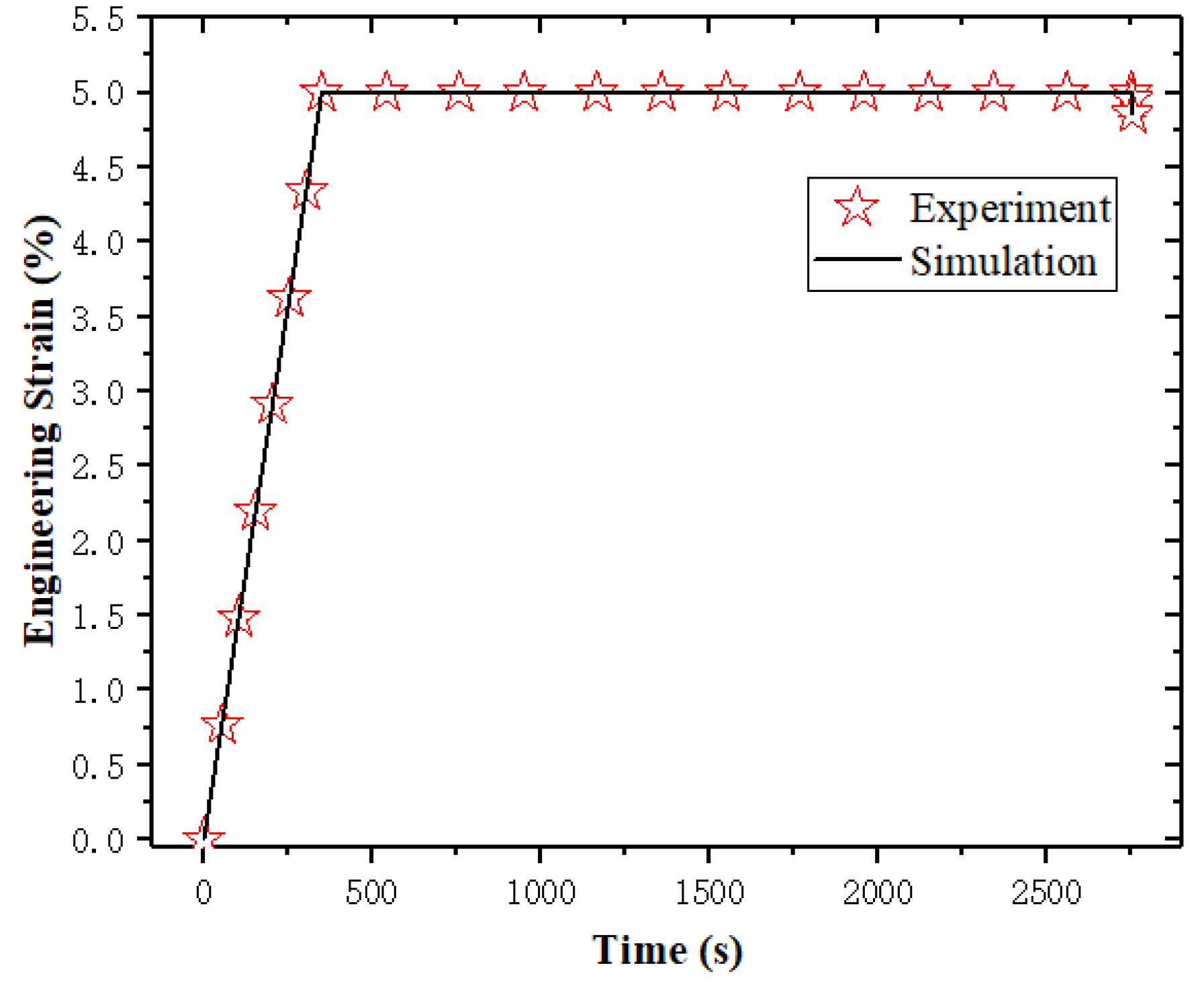

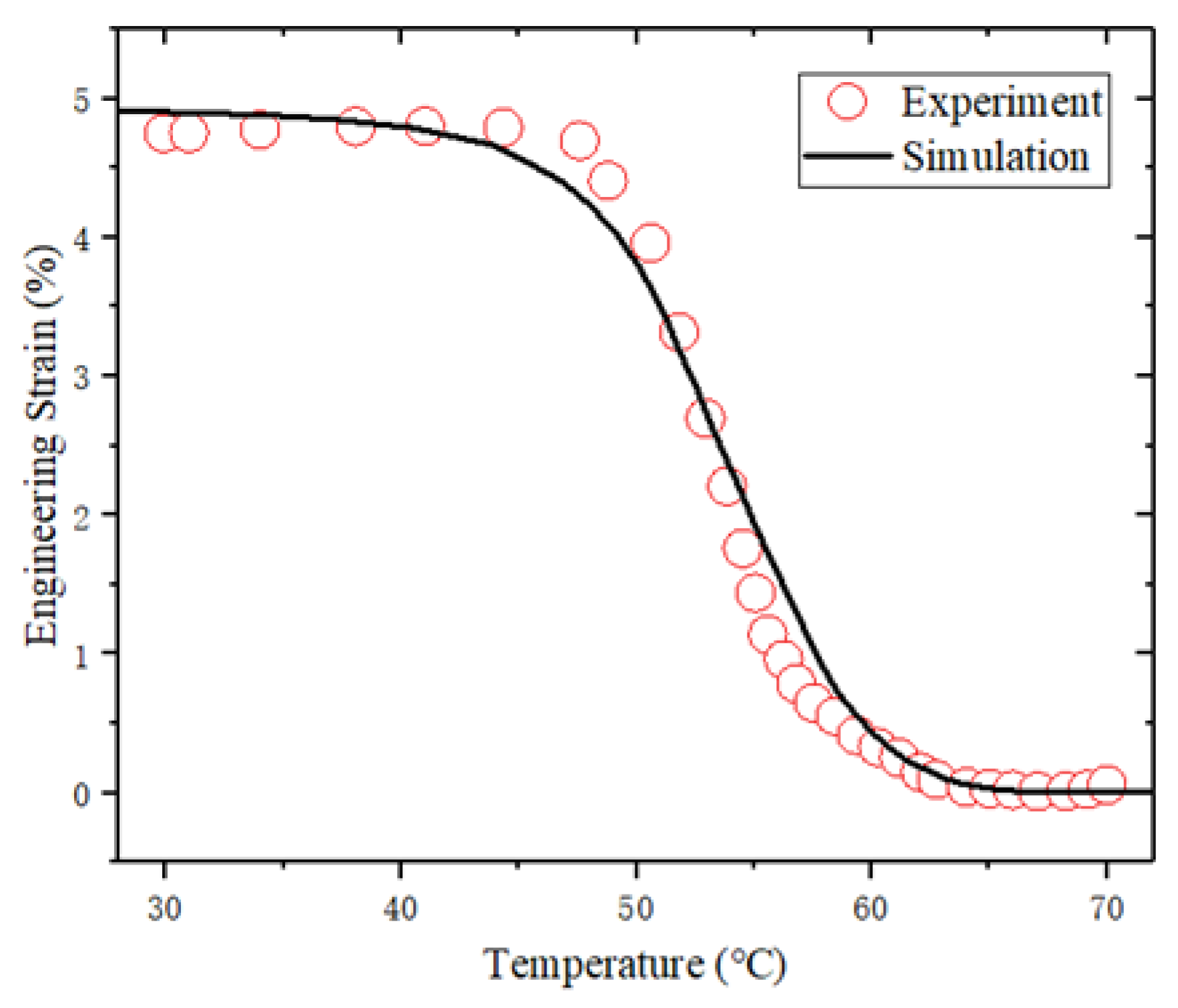
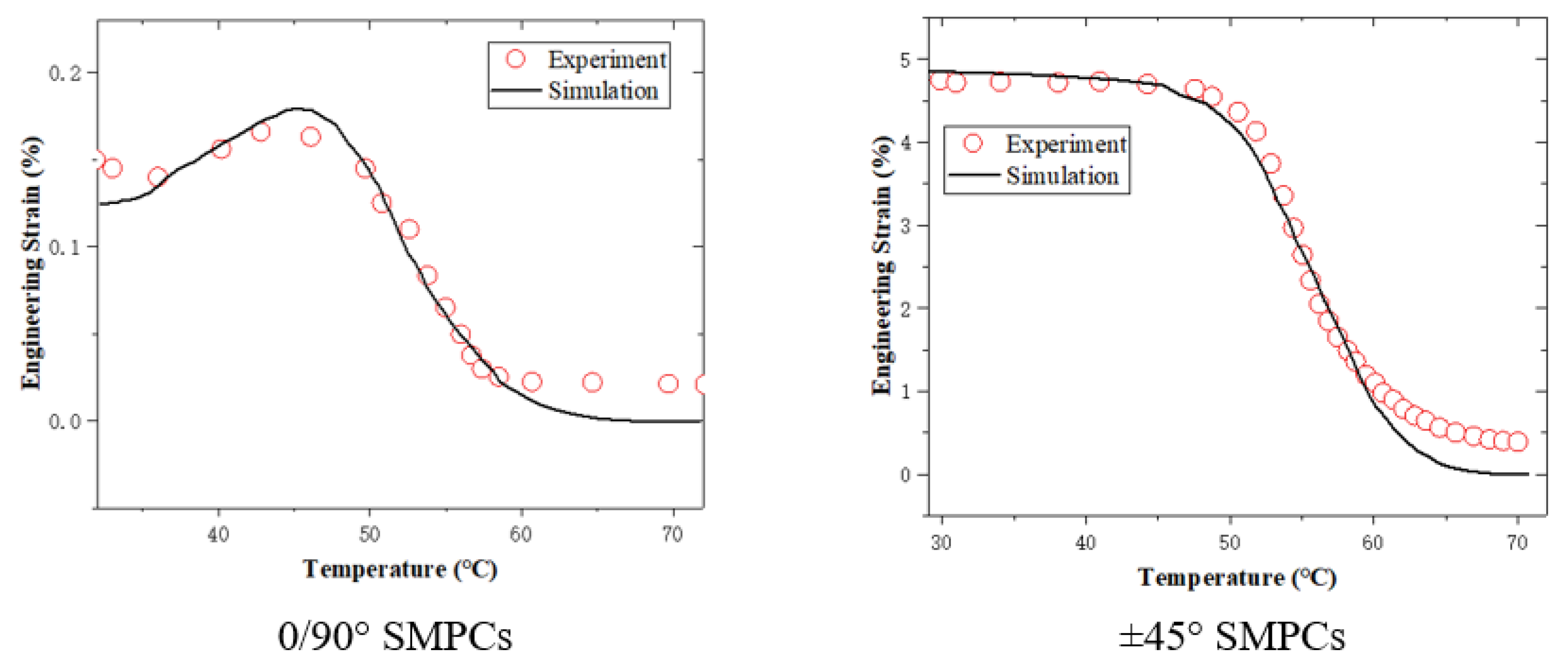


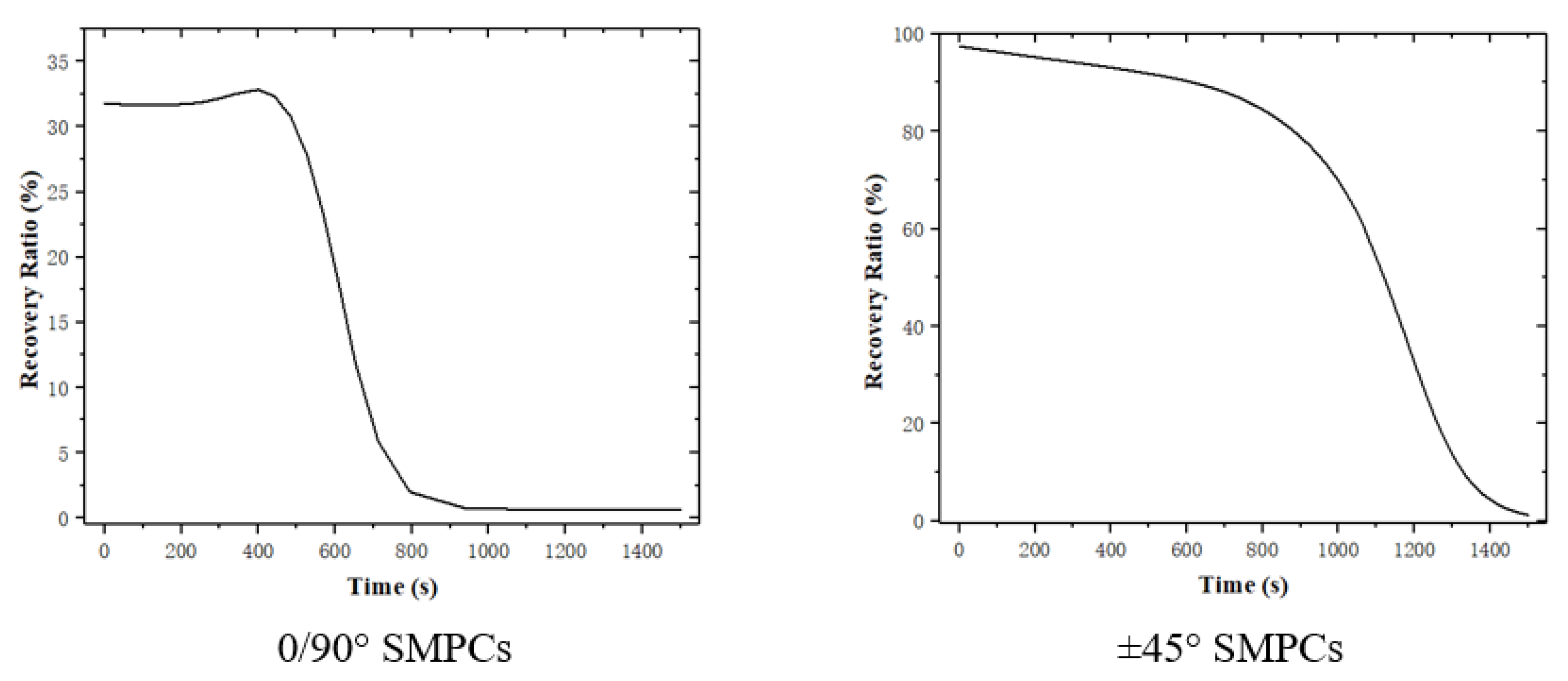
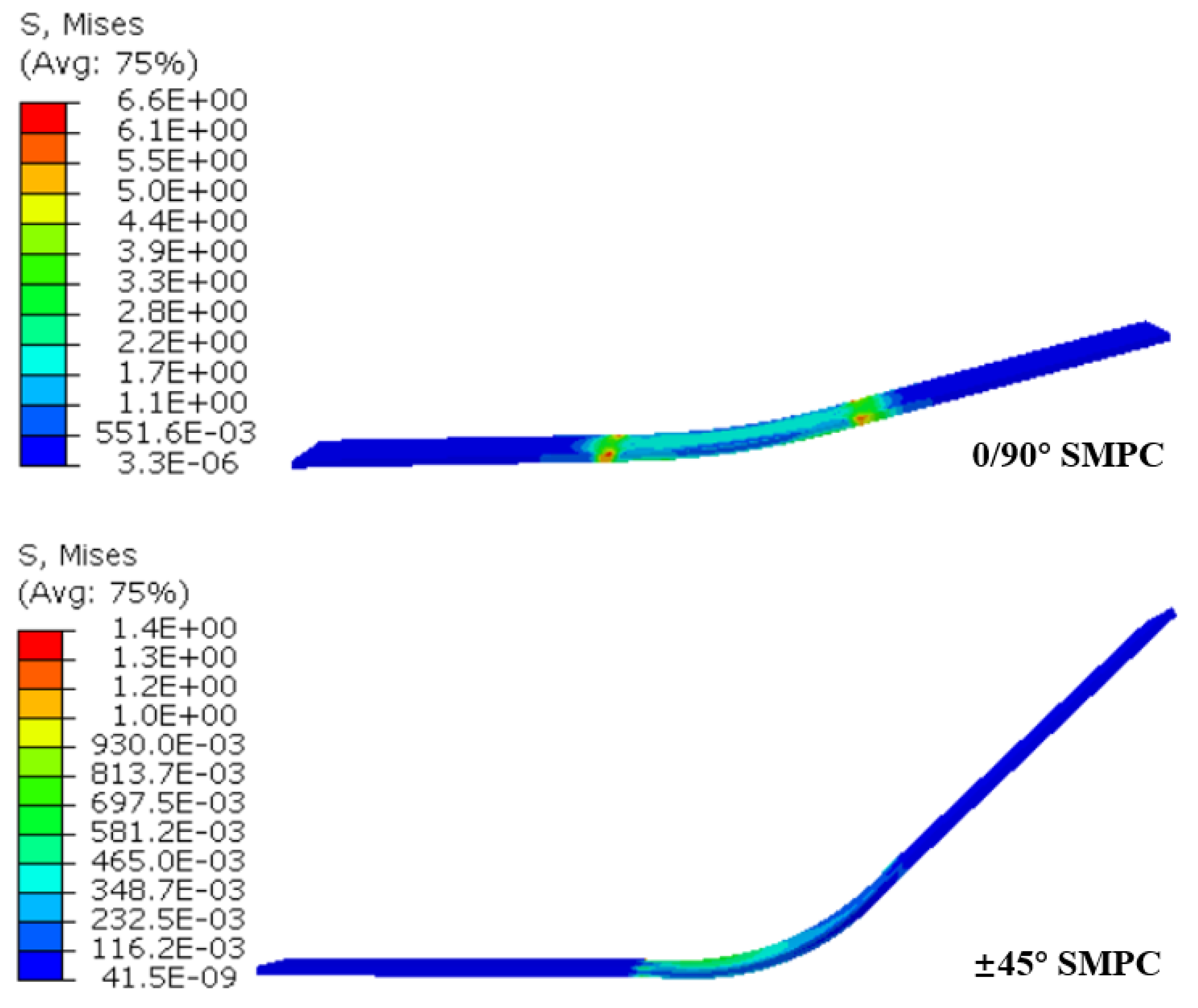
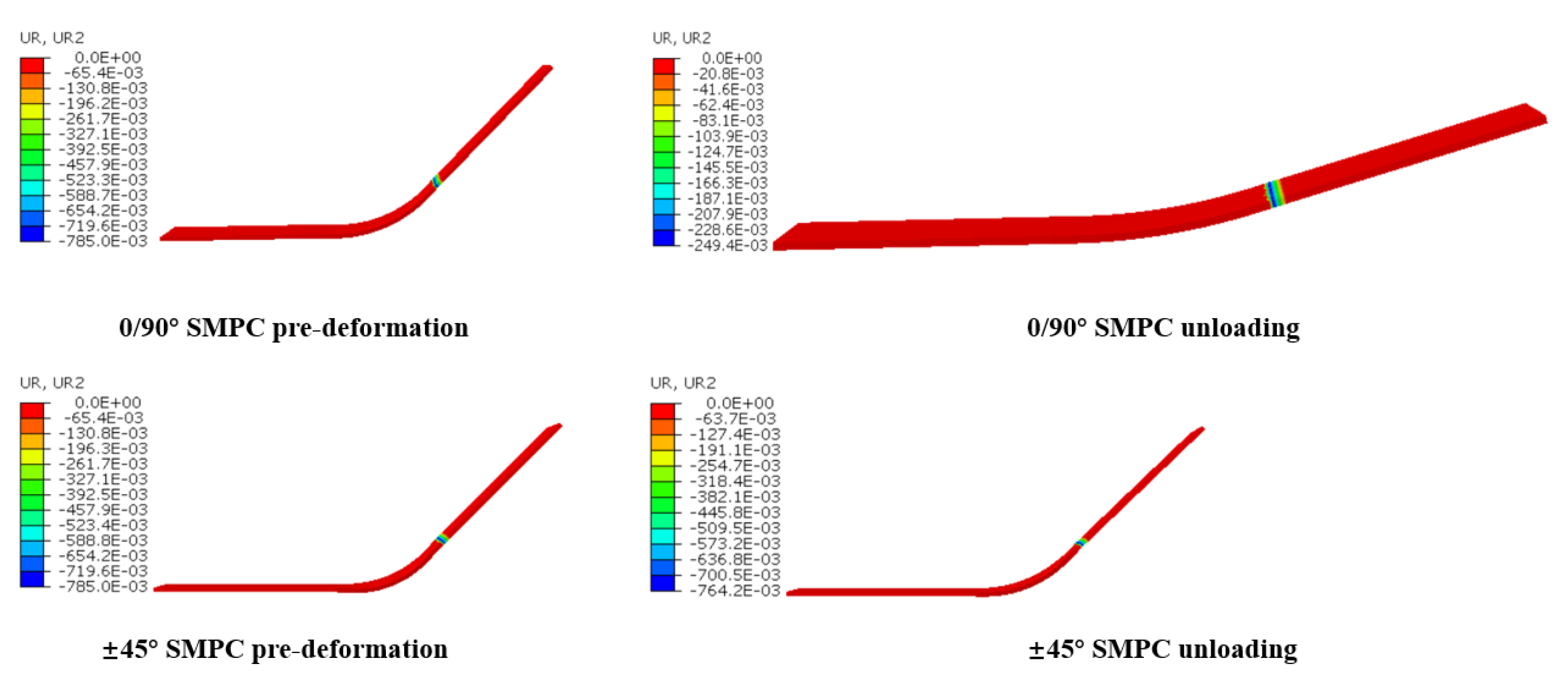
| Parameters | Value | Unit | |
|---|---|---|---|
| Matrix | 1.8, 0.9, 160, 25 | MPa | |
| −2850 | K−1 | ||
| 0.25 | °C−1 | ||
| 43 | °C | ||
| 5.57 × 10−3 | MPa−1 | ||
| 5.0 × 104 | MPa·s | ||
| Fiber | 3690, 3620, 115 | MPa | |
| 300, 220, 170 | MPa | ||
| 0.7, 0.01 |
Disclaimer/Publisher’s Note: The statements, opinions and data contained in all publications are solely those of the individual author(s) and contributor(s) and not of MDPI and/or the editor(s). MDPI and/or the editor(s) disclaim responsibility for any injury to people or property resulting from any ideas, methods, instructions or products referred to in the content. |
© 2023 by the authors. Licensee MDPI, Basel, Switzerland. This article is an open access article distributed under the terms and conditions of the Creative Commons Attribution (CC BY) license (https://creativecommons.org/licenses/by/4.0/).
Share and Cite
Wang, Y.; Wang, Z.; Ma, J.; Luo, C.; Fang, G.; Peng, X. A 3D Anisotropic Thermomechanical Model for Thermally Induced Woven-Fabric-Reinforced Shape Memory Polymer Composites. Sensors 2023, 23, 6455. https://doi.org/10.3390/s23146455
Wang Y, Wang Z, Ma J, Luo C, Fang G, Peng X. A 3D Anisotropic Thermomechanical Model for Thermally Induced Woven-Fabric-Reinforced Shape Memory Polymer Composites. Sensors. 2023; 23(14):6455. https://doi.org/10.3390/s23146455
Chicago/Turabian StyleWang, Yingyu, Zhiyi Wang, Jia Ma, Chao Luo, Guangqiang Fang, and Xiongqi Peng. 2023. "A 3D Anisotropic Thermomechanical Model for Thermally Induced Woven-Fabric-Reinforced Shape Memory Polymer Composites" Sensors 23, no. 14: 6455. https://doi.org/10.3390/s23146455





